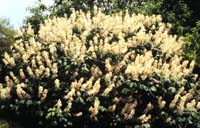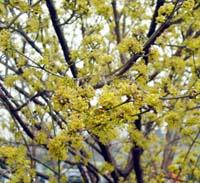Look for Appropriate Landscape Plants that Expand Season
Look for Appropriate Landscape Plants that Expand Season


Cornus mas Photo by Laura Skillman
Now that spring has sprung, homeowners will soon be heading to their local garden stores looking for plants to add to their landscape. When looking, don’t forget to read the labels and think about which plants might add longer color and interest in the garden.
While the brightly blooming plants in the garden center may attract the eye, don’t forget to consider plants that may have already bloomed or will bloom later in the year, said Winston Dunwell, an Extension horticulture specialist at the University of Kentucky College of Agriculture’s Research and Education Center in Princeton. These plants will help lengthen the season in your garden and provide months of enjoyment.
When considering very early flowering herbaceous perennials, hellebores such as Lenten rose are a good option. It is almost a winter bloomer and is very attractive in February and March but likely will not be in bloom when many people head to their garden centers. So they want to keep that in mind.
“Another that we enjoy here at the Experiment Station is Cornus mas Golden Glow,” Dunwell said. This small tree has peeling, reddish bark with a creamy white undercoat. It has a very early yellow bloom and the blooms seem to be very hardy. It can hold its yellow color for a long period of time.
“This would be one where they might go to the garden center and see a pretty barked tree and they’d need someone to point out what the blooms look like,” he said.
Plants native to Kentucky are always good choices when looking to add to the garden, he said. Witchhazels, Hamamelis, include many modern cultivars offering an array of colors. They do not have large petals but they are very fragrant. Arnold’s promise, with its yellow blooms, is a late cultivar that might be seen in bloom in garden centers. That has helped to make it one of the most popular ones. If the garden center has other cultivars, a gardener can get a broad color spectrum. The care is easy.
The serviceberry is in bloom by the roadside now and many people think of it as either ornamental pear or some kind of fruit tree. Serviceberry has a white bloom in February and is quite airy looking. One of the cultivars recommended in the Theodore Klein plant series is Amelanchier “Cumulus.” There are several varieties that are native to Kentucky, and people once made jams and jellies out of them. They have a small purple or black fruit.
“Again, this one might not be blooming in April or May when they go to the garden center, but it is one they should consider adding to their garden,” Dunwell said. “What we are trying to do is to extend their garden season bloom, good foliage and fruit so they can get more enjoyment out of it and not add a lot of care with a lot of plants.”
A sweet bay magnolia tree, native to Kentucky, is an excellent tree to consider. It has magnolia-like, although smaller, blooms and is very fragrant. The leaves are silver underneath and offer a real show in the wind. It is very tolerant of growing conditions and easy to grow, he said.
Crocuses and daffodils are spectacular, but a gardener must remember to plant them in the fall and protect them from rodents until they get established. They are very good plants to add color to the garden in early spring as well.
Other plants that will bloom later in the season that can offer added interest in the garden are plants such as bottle brush buckeye, which grows eight to 10 feet high and has a 12 to 18 inch white bottle brush-type bloom.
“They are spectacular in bloom and have good green foliage that holds up well for a buckeye,” Dunwell said. “The fall color is a light pale yellow, which is nice. The only thing that might be an issue is that they are large for a shrub (8 to 10 feet tall) and once they are well established might drop some seed. For most people, that is good because they can use the seed to grow more plants to share with others.”
Blueberries can also make an interesting addition to a landscape. They have beautiful blooms, fruits that can be enjoyed and are healthful and have interesting fall color.
“If you want a plant that does it all, a simple blueberry or native huckleberry would be a good choice,” he said.
When planting, be aware that some plants can be invasive and may soon outgrow small areas or require a lot of maintenance to keep them under control. These need to be placed in an area where they can have plenty of room to grow and show themselves.
“Not everyone can afford professional designs, so when a person goes to the garden center they need to read the label,” Dunwell said. “If it says it will grow 40 feet tall, it is not going to fit under the power line in the front yard. You need to consider if the plant will fit the site. A Colorado blue spruce shouldn’t be planted by the front door. But don’t be afraid to try some things.”
Many of theses plants have been among the list of Theodore Klein award winners. The plant awards are named to honor the late Theodore Klein of Yew Dell Nursery in Crestwood.
The program began in 1995 with the goal of selecting and promoting outstanding ornamental woody and perennial plants for Kentucky landscapes. Plants are selected by an independent committee which is sponsored by the University of Kentucky Nursery/Landscape Program, the Kentucky Nursery and Landscape Association, and Yew Dell Gardens.
More information about these plants can be found at:http://www.ca.uky.edu/HLA/Dunwell/TKleinPA.html.
